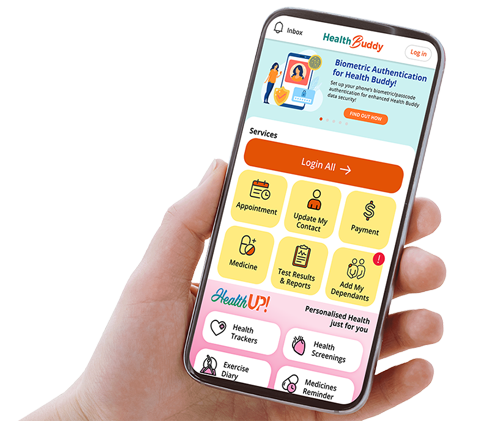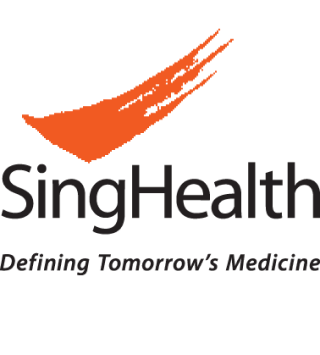Changi General Hospital will NEVER ask you to transfer money over a call. If in doubt, call the 24/7 ScamShield helpline at 1799, or visit the ScamShield website at www.scamshield.gov.sg.
The Changi General Hospital (CGH) care team exemplifies the spirit of compassion in providing critical medical services to earthquake survivors in Myanmar.
By Ms Belinda Wan, CGH

Prof Ng Wai Hoe, Group CEO, SingHealth (far left) and Clin Prof Ng Kee Chong, CEO, CGH (far right) with the SGEMT members who set off to Myanmar on 3 April 2025 to provide emergency medical relief.
Following the catastrophic 7.7-magnitude earthquake that struck Mandalay, Myanmar, on 28 March, the country’s second-largest city suffered widespread damage and numerous casualties.
In response, the Singapore Ministry of Health swiftly deployed the Singapore Emergency Medical Team (SGEMT) — including five multidisciplinary healthcare professionals and a crisis planning staff from CGH — to support medical relief efforts in central Myanmar. During the 14-day Operation Falconwing deployment, the 34-member team established and operated a field hospital to address urgent medical needs in the affected region.
Overcoming real-time challenges
Working in sweltering heat, the SGEMT team adapted to unfamiliar local site conditions, language barriers and limited infrastructure. Together with local authorities and volunteers, they provided emergency medical care to patients, many of whom had gone without treatment for days due to challenges in accessing medical aid.
“The team saw a total of over 1,800 patients in just a week — exceeding our initial projection of 1,400 patients for a two-week period that we prepared for,” shares Clinical Professor Ng Kee Chong, Chief Executive Officer, CGH, who spearheaded the SGEMT efforts. He is also Deputy Group Chairman Medical Board (Disease Outbreak & Preparedness), SingHealth.
The field hospital attended to a diverse range of patients daily, from a 50-day-old infant to the elderly in their 80s. Many suffered from untreated cuts, fractures and muscular pain sustained from the quake or from sleeping on hard ground. A number of patients with uncontrolled diabetes and hypertension had also lost their chronic medication in the quake. Some also suffered from psychological trauma.
Despite the patients’ dire circumstances, Dr Patricia Lee, Senior Consultant, Department of Family Medicine, CGH, was moved by the strength of their spirit. “Some had lost their homes, others were grieving,” says Dr Lee. “Yet even something as simple as a comforting word or medication made a difference.”
Dr Sim Guek Gwee, Senior Consultant, Department of Emergency Medicine, CGH, who oversaw consultation and resuscitation, noted that patient volumes quickly exceeded expectations. "Every day, we refined our workflows to keep things running smoothly. Teamwork made that possible," says Dr Sim.

The team was met with long queues of patients every day needing emergency and primary care.


Dr Patricia Lee and Dr Sim Guek Gwee attended to diverse patients with a variety of medical conditions.
Care on the ground
CGH nurses worked closely with other SGEMT members to meet diverse patient needs. They supported triage, wound care, observation and medication logistics, rotating across stations when needed.
Muhammad Rakib Bin Muhd Ridhauan, Assistant Nurse Clinician, Department of Emergency Medicine, CGH, took on several roles in triage, treatment and resuscitation, while managing the pharmacy’s inventory and performing point-of-care testing. He recalls a hypertensive patient who returned every morning to greet the team after his condition had stabilised and he was discharged. “His genuine smile and heartwarming presence reminded us that even small gestures of care can leave a lasting impact,” says Mr Rakib.
For Nurul Radiah Binte Mohd Salleh, Senior Staff Nurse, Department of Specialty Nursing, CGH who led wound care in the treatment zone, Operation Falconwing highlighted the importance of teamwork and staying flexible. “We had to prioritise care, apply triage principles strictly and be innovative with resources,” recalls Ms Radiah. “Everyone stepped up, and the strong team dynamics made it possible to manage the situation effectively.”
At the observation tent, Nurhafizan Binte Mohamed Alifi, Nurse Clinician, CGH, saw patients with pain and mobility issues. An orthopaedic nurse, she partnered with an SGEMT physiotherapist to provide guidance on exercise and the use of mobility aids. “We provided a lumbar corset to a patient with shooting pain down her lower limbs. She was overjoyed when the pain subsided and she could dance again. It is gratifying that we can help restore mobility and confidence,” Ms Nurhafizan shares.

CGH Nurse Clinician Nurhafizan Binte Mohamed Alifi explaining the medicine prescriptions to patients.

A trio of CGH nurses work alongside fellow SGEMT members to set up the field

CGH Crisis Planning and Operations Senior Assistants Manager Zheng Xinye helped track the number of patients seen each day.
A well-oiled machine
Behind the scenes, Zheng Xinye, Senior Assistant Manager, Crisis Planning and Operations Department, CGH, worked to keep operations flowing smoothly through the evolving situation. Despite location shifts, weather disruptions and tight timelines, clear coordination within the SGEMT team and rapid workarounds — along with the support and help of the locals — made it work.
Mr Zheng was especially moved by the resilience of local nurses and Myanmar Red Cross volunteers. “Their strength left a deep impression,” he says.
Clin Prof Ng adds that the SGEMT team showed tenacity in the face of challenges during the mission. “They demonstrated how acts of kindness can transform lives through their compassionate care beyond hospital walls,” he says.

The CGH team was greeted with a warm reception at the airport after the 14-day Operation Falconwing.
Stay Healthy With
© 2025 SingHealth Group. All Rights Reserved.


















